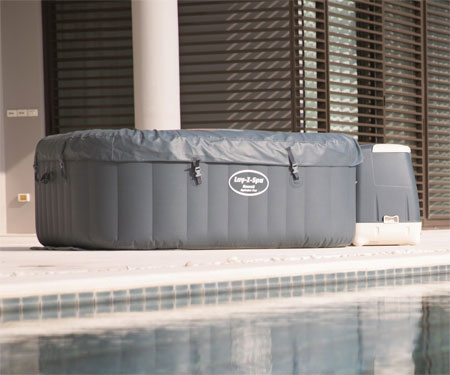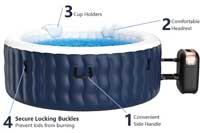When I shopped for my first hot tub, my biggest concern was cost. I didn’t want to pay too much for spa itself, but I also didn’t want to pay a huge heating bill each month either. So, what is the cost of running a hot tub?
My Decision Made Easier…
First of all, I didn’t have to worry about choosing between a gas vs electric hot tub because the portable versions are typically designed electric. This immediately made my decision-making much easier. That said, I still didn’t want to get ripped off.
What I Found Out About the Cost of Running a Hot Tub:
Let’s break down the overall cost of owning a 4-person Intex spa, considering various factors:
- Initial Purchase: The cost of an Intex 4-person inflatable spa can range from $300 to $800, depending on the model and included accessories.
- Running Expenses: Monthly electricity costs to run the spa average around $20 to $50, depending on usage, local energy rates, and insulation efficiency.
- Maintenance Expenses: Yearly maintenance costs include chemicals, filters, and occasional repairs, totaling around $200 to $300 annually.
- Water Usage: Filling and replacing water periodically contribute to the overall cost, adding an estimated $50 to $100 annually.
- Long-Term Efficiency: Upgrading to a more energy-efficient model or using energy-saving practices, like insulated covers, could save approximately 10% to 20% on monthly heating costs, amounting to potential savings of $50 to $100 per year.
- Total Cost Over Time: Considering an average lifespan of 5 to 7 years for the spa, the overall cost of ownership ranges from $2,500 to $4,500, including initial purchase, running expenses, maintenance, and potential efficiency improvements.
- Savings and Efficiency: Implementing energy-saving measures and proper maintenance routines can lead to cumulative savings of $300 to $600 over the spa’s lifespan.
Understanding these factors helps gauge the total investment in an Intex 4-person inflatable spa, factoring in both initial purchase and ongoing operational expenses, alongside potential savings through efficiency improvements and diligent maintenance.
1. How Long Does it Take to Warm Up an Inflatable Spa?
An electric hot tub heater will warm the water more slowly than the gas version. (An electric unit usually heats at about 2-3 degrees per hour.) However, a well-insulated spa can be kept heated (efficiently) all the time, making the heating time a null point.
2. Tips to Lower Your Hot Tub Heating Costs:
There are several tricks that spa owners can use to lower operating costs:
- If you’re on the fence about which size to buy, opt for the smaller model. Less water to heat means less heating cost. Compare inflatable spa sizes here.
- Position your spa in a protected area, such as against a corner wall or on a covered patio.
- Minimize exposure to the outdoor elements and this can decrease the power needed to keep your spa warm.
- If you plan on using your unit indoors, this will save you even more money as you can control the air temperature as well.
- Take advantage of hot tubs that come with insulated lids and/or insulating floor pads. Covers are especially important because heat rises and can easily escape when lids are not in place.
- The outdoor temperature makes a difference on the energy it requires to keep a spa warm Using your hot tub during the summer months instead of during the winter is another way to keep heating costs at a minimum.
Ways to Optimize Heat Settings for Best Efficiency:
- Temperature Moderation: Set the spa’s temperature to a comfortable level, typically between 100°F to 104°F (37°C to 40°C), avoiding excessively high temperatures that consume more energy.
- Pre-Heating Timing: Use a timer to heat the spa a few hours before use, ensuring it’s ready while minimizing continuous heating.
- Lower Temperature at Rest: Lower the spa’s temperature slightly during periods of inactivity or when not in use to reduce heating costs.
Tips to Reduce Spa Heating Cost in Winter:
Here’s advice on heating an inflatable hot tub during winter and reducing heating costs:
- Optimal Placement: Place the tub in a sheltered area, shielded from cold winds, to minimize heat loss.
- Quality Insulation: Invest in a thermal blanket or insulating cover to retain heat and reduce heating time and costs.
- Scheduled Heating: Set a timer to heat the tub just before use rather than keeping it consistently hot.
- Lower Ambient Temperature: Lower the tub’s temperature slightly to conserve energy without compromising comfort.
- Regular Maintenance: Keep the tub well-maintained, ensuring seals, insulation, and heater efficiency are in top condition.
- Minimize Heat Loss: Limit the tub’s exposure by promptly closing the cover after use and avoiding unnecessary lid opening.
- Strategic Heating Hours: Take advantage of off-peak energy hours for heating to save on electricity costs.
- Consider Solar Covers: Utilize solar covers during the day to harness free heat from the sun, reducing reliance on the heater.
- Monitor Usage: Be mindful of usage frequency and duration to optimize heating while reducing overall energy consumption.
- Check Seals and Covers: Regularly inspect seals, covers, and insulation to identify and fix any areas causing heat loss.
Following these tips helps maintain a comfortable temperature in your inflatable hot tub during winter while minimizing heating expenses.
This video has a review of the Intex PureSpa. Check out minute 0:43 for information on the insulating cover and minute 5:23 for information on the thermal ground cover that insulates the spa from underneath:
As you can see, there are many variables that can affect the cost of heating an inflatable hot tub. Intex provides a useful chart on this page that demonstrates different heating costs depending on usage. (Approximately $30 a month in mild weather conditions for an average sized spa).
3. 220 volt VS 110 volt for Heating a Spa?
According to The Spa Depot, a 220v electric heater can heat the water more quickly than a 110v unit. The cost is virtually the same either way. 110v is usually more practical, since owners can simply plug in the unit and start using it right away.
4. More Heat = Better Value?
There’s one surprising thing that I realized once I started using my hot tub. By having it heated all the time, I ended up using more often that I thought. Many times I just get in it for 10 or 15 minutes to take a quick break, relax or meditate.
WebMD reports studies that show improved sleep, better mental health and even workers reporting fewer sick days from regularly using hot tub therapy. This may explain why I feel so good! even from these short sessions.
Since it is ready to go whenever I need it, I never have to put extra thought into pre-heating it. I think for this reason alone I’ve gotten a lot more of my money’s worth out of it.
5. But What About a Gas VS Electric Heater?
Although we’ve already discussed that a gas heater wasn’t an option for me, there were a few other facts that came up that helped me feel better about my buying decision. Electric spas are simpler to operate and easier and cheaper to fix should anything ever go wrong.
I also didn’t need to provide extra ventilation as would be needed with a gas tub or hire a professional for that matter. Not only do these factors make installation and upkeep less convenient, they also add on to the cost.
Great Northern Hot Tubs makes a good point when evaluating electric vs gas in regards to cost: “If you can recover the cost of the heater and installation in 5-7 years and install the heater indoors, get the gas heater. However, if it’s going to take 10 to 20 years to recover installation costs and you’re only going to live in the house for 5 years, you’ve just lost the money. For most people, a 6 kW electric heater is the most practical.”


